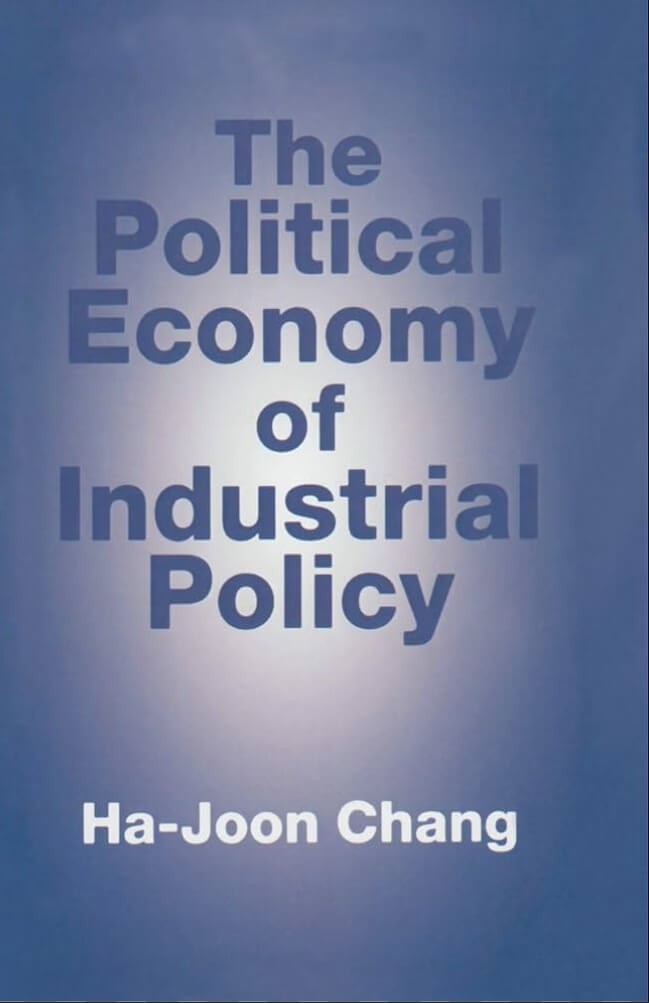Is economic development really just about “getting prices right”? Or is there more to growth than free markets and competition? In The Political Economy of Industrial Policy, Ha-Joon Chang challenges one of the central assumptions in mainstream economics: that government intervention in the economy is inefficient, unnecessary, or even dangerous.
First published in 1994, this was Chang’s first major academic work — and it laid the foundation for his later, more accessible books. It remains a cornerstone text for anyone trying to understand the hidden role governments play in shaping industrial success stories. Rigorous, evidence-rich, and intellectually fearless, the book makes one thing clear: without active state involvement, most of today’s wealthy nations would never have become industrial powers.
💡 Why This Book Still Matters
In a time when debates over industrial policy are returning — from the U.S. CHIPS Act to EU green subsidies to China’s state-led development — The Political Economy of Industrial Policy is more relevant than ever. Long before it was fashionable, Chang was arguing that countries need to build industries — not just hope that markets will deliver them.
This book is not a casual read — it’s written for economists, policymakers, and serious students of development. But if you’re willing to dig in, it rewards you with a deep understanding of why markets alone rarely generate innovation, manufacturing strength, or technological leadership.
🧠 The Core Idea
Chang’s central thesis is straightforward but bold: Industrial policy — government efforts to promote specific industries — is not only viable but essential for economic development.
Mainstream economics, especially since the 1980s, has argued the opposite. According to the dominant neoclassical school, governments should not “pick winners” because they can’t know better than the market. Chang flips this script by showing:
⦁ Many of the world’s industrial success stories (e.g., South Korea, Japan, Taiwan, Germany) relied on strong, targeted government intervention.
⦁ The U.S. and Britain used similar policies during their development periods — even though they now tell developing countries to avoid them.
⦁ Markets are not neutral or automatic — they are created and shaped by policy decisions, institutions, and political power.
📚 Structure of the Book
The book unfolds in three tightly argued sections:
Part 1: Theoretical Background
Chang begins by dissecting the neoclassical case against industrial policy, examining arguments about market failure, government inefficiency, and comparative advantage. He critiques the assumption that state intervention always leads to “distortion,” pointing out that markets themselves are already distorted — often by power, history, or monopoly.
Part 2: The Case for Industrial Policy
Here, Chang builds the case for why governments should — and often must — guide economic transformation. He discusses:
⦁ Infant industry protection: Newly emerging sectors need time to grow before competing globally.
⦁ Technological catch-up: Advanced industries often require long-term investment, which markets underprovide.
⦁ Strategic coordination: The state can help align education, finance, infrastructure, and R&D toward industrial goals.
He shows that successful countries often didn’t wait for the market to allocate resources “efficiently” — they made strategic bets and built institutions to support them.
Part 3: Historical Case Studies
The most compelling part of the book might be its historical analysis. Chang provides detailed evidence from:
⦁ South Korea’s post-war industrial boom, where state planning and credit control fueled the rise of firms like Samsung and Hyundai.
⦁ Japan’s Ministry of International Trade and Industry (MITI), which steered innovation and technology transfer.
⦁ 19th-century Britain and the U.S., both of which used tariffs, subsidies, and patent manipulation to gain industrial leadership.
These examples reveal a consistent pattern: industrial policy has worked — and continues to work — when tailored wisely to national context.
✅ Why You Should Read This Book
It Rewrites the History of Growth
If you think countries got rich by letting markets run free, this book will change your mind. It’s a masterclass in economic history, exposing the myths behind “laissez-faire success stories.”
It Arms You for Policy Debates
Whether you’re in government, development, or just trying to understand global economics, this book gives you the tools to question IMF orthodoxy and trade prescriptions. It’s especially relevant in an era of reshoring, climate policy, and technological rivalry.
It Balances Theory with Real-World Examples
Chang is both a theorist and a practitioner. He doesn’t just argue abstractly — he grounds his points in case studies, statistics, and historical comparisons.
🎯 Real-World Relevance
Industrial policy is back — even in places that once mocked it. From Biden’s “Made in America” push to EU clean-tech subsidies to China’s ongoing state capitalism, the world is moving away from blind faith in free markets. This book helps explain:
⦁ Why industrial policy is making a comeback
⦁ What makes it succeed (or fail)
⦁ How developing countries can grow in a post-neoliberal world
Chang’s work offers a powerful counter-narrative to decades of free-market ideology and provides a roadmap for strategic, inclusive development.
⚠️ Where the Book May Challenge You
It’s Academically Dense
This is not a “pop economics” book. It’s detailed, footnoted, and written for serious readers. That said, the prose is clear, and the arguments are always backed by data — so it’s rewarding if you stick with it.
It Demands Rethinking Familiar Ideas
Many readers have been taught that state intervention causes inefficiency and failure. Chang asks you to reconsider that — and for some, that can be a difficult shift.
💬 What Readers and Critics Say
“A scholarly tour de force” — Academics in development studies and political economy consider this a foundational text.
“Required reading for any serious policymaker” — Those involved in economic planning or trade policy use Chang’s work to justify alternative strategies.
“Still relevant after 30 years” — The book’s core message has aged well, and many of its warnings about globalization and deindustrialization now seem prescient.
📈 Final Verdict: ★★★★☆ (4.5/5)
The Political Economy of Industrial Policy is a rigorous, powerful, and compelling defense of something mainstream economists long declared taboo: that governments can and should shape economies.
If you’re looking for an accessible intro to economics, start with Economics: The User’s Guide or 23 Things. But if you want to go deeper — to understand how industrial success really happens — this book is essential.
Chang reminds us that markets are not natural forces. They’re designed, maintained, and steered — often for better, sometimes for worse. And if we want an economy that builds industries, reduces inequality, and fosters innovation, we may need more planning, not less.




